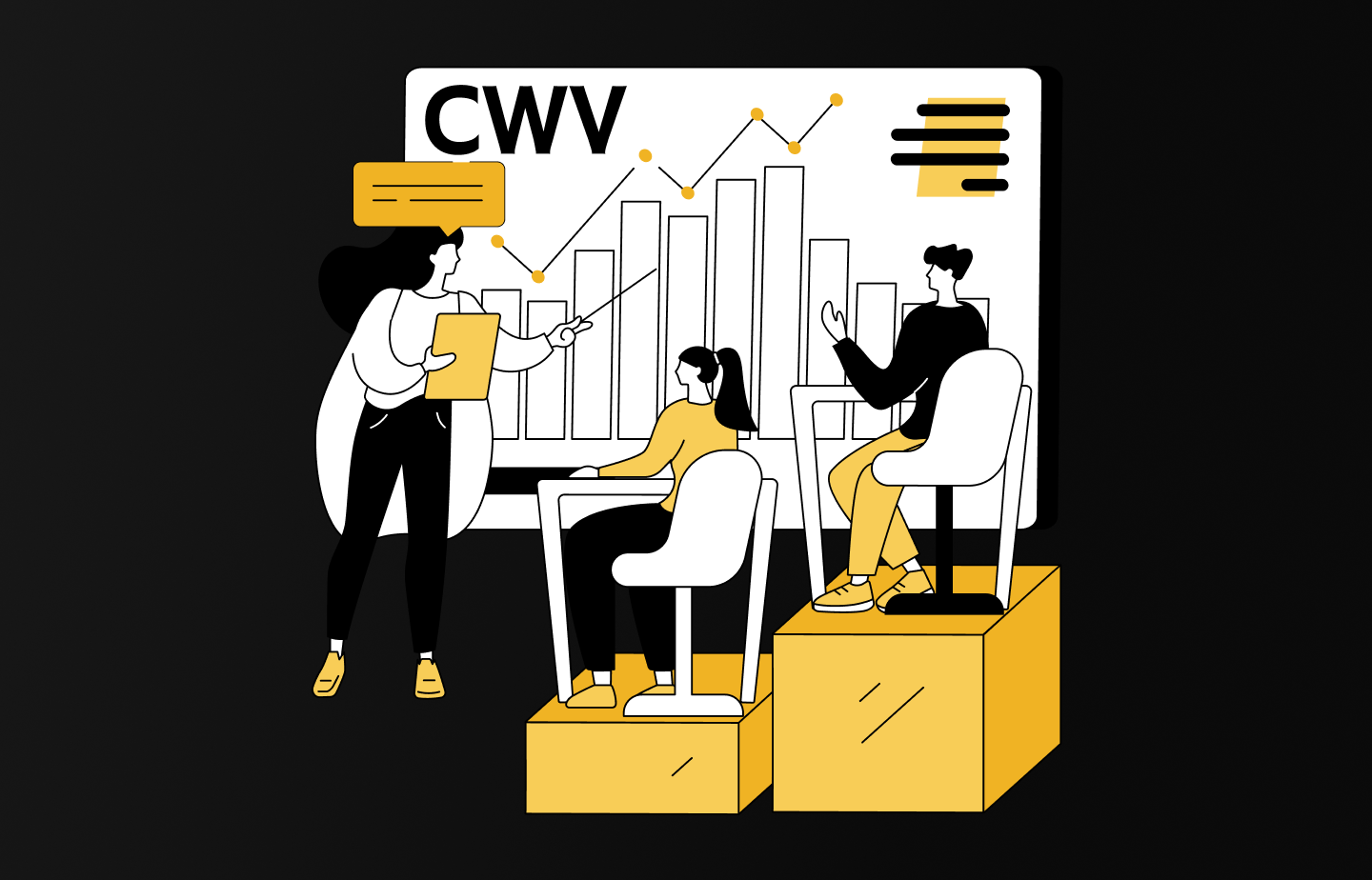What’s the difference between a website that loads lightning-fast and a website that seems to painfully take its time? Well, the former will rank significantly higher on search engines due to having a lower Largest Contentful Paint (LCP), one of the three key metrics in Core Web Vitals (CWV).
This article unravels what LCP is in relation to CWV, its significance, how to measure it, and its overall impact on your SEO rankings and user experience.
LCP in Core Web Vitals
Before we explore the fundamentals of LCP, it’s first important to understand its background.
This is where Core Web Vitals (CWV) comes in–it’s a set of metrics introduced by Google itself that’s designed to assess various aspects of web performance. It has three major components including Largest Contentful Paint (LCP) along with First Input Delay (FID) which is set to change to Interaction to Next Paint (INP) in March 2024 and Cumulative Layout Shift (CLS).These three collectively provide web developers with a comprehensive data to measure and improve a website’s performance.
LCP is the first impression-maker among the three, and first impressions on your website can make or break its search engine ranking and user experience.
What is LCP?

Largest Contentful Paint (LCP) is a user experience metric that gauges the loading performance of a web page. It measures the time it takes for the largest and most significant elements to show up and become available for user interaction. These elements can be any form of media such as images, banners, and videos, or textual elements such as taglines and text blocks.
In simpler terms, LCP focuses on the moment when users can see and interact with the primary assets on your website. It’s like a speedometer that keeps tabs on how quickly the main content shows up when you open a webpage.
Why is LCP Important?
LCP plays a crucial role in determining the perceived performance of a site, thus positively impacting search engine rankings. Websites that nail the LCP game not only keeps their users hooked, but are also more likely to show up on the first few search results.
The loading speed of a webpage also directly influences user satisfaction and engagement. When a site loads quickly, users are more likely to stick around, enjoy their time there, and possibly even do some more clicking and exploring.

This reduces bounce rates and since users are less likely to bail out without doing anything, increases the chances of conversion or turning them into customers.
Factors Influencing LCP in Core Web Vitals
Several factors contribute to your website’s overall LCP, each playing a crucial role in contributing to the user’s perception of a site’s responsiveness and usability. Identifying and understanding these details and how they influence LCP will be essential in optimizing your websites for better performance.
The four main factors that significantly affect LCP are:
-
Image and Video Loading

Rich media content, such as images and videos, often make up a significant portion of your webpage’s visual elements. The time it takes for these assets to load can significantly impact LCP. Optimizing images through compression techniques, lazy loading, and leveraging modern image formats can contribute to faster loading times, reducing the overall LCP.
-
Text and Font Rendering

The rendering of text and fonts is another crucial factor influencing LCP. If the user’s browser struggles to render text efficiently, it can lead to delayed content visibility. You can enhance text rendering by optimizing font files, utilizing system fonts, and minimizing unnecessary styling. Prioritizing the loading of essential fonts can also accelerate the LCP and improve overall user experience.
-
Server Response Times

The time it takes for your server to respond to a user’s request is a determining factor in determining LCP. Slow server responses can lead to delays in fetching necessary resources, hindering the timely display of content. Employing content delivery networks (CDNs), optimizing server configurations, and utilizing efficient caching mechanisms are strategies that can contribute to faster server response times and eventually improve LCP.
-
Network Conditions

The speed and reliability of your user’s network connection also plays a significant role. Thus, you need to make sure to accommodate your website considering various network conditions, including slower connections or intermittent connectivity. Implementing performance optimizations like code splitting, resource prioritization, and preloading critical assets can mitigate the impact of variable network conditions on LCP.
How to Measure LCP
Now that we have identified the factors that influence LCP, the next thing in line should be understanding how it is measured. This will allow you to have an actual reference for gauging and improving your website’s performance.
There are two main methods in measuring LCP:
- Field Data: Gathered from real user experiences.
- Lab Data: Acquired through simulations in a controlled environment.
Using Browser Developer Tools
Browser developer tools aren’t exclusive for tech experts. Nearly every browser has developer tools that reveal insights into your website’s performance. Open them up, play around, and you’ll surely come across LCP. It’s like having a backstage pass to your website’s speed metrics.
Here are some examples for popular browsers:
Google Chrome 
- Performance Panel: Detailed loading timeline, includes LCP metrics.
- Lighthouse: Integrated tool, offers a comprehensive report on various metrics.
Mozilla Firefox 
- Network Monitor: Inspects resource loading, aiding LCP understanding.
- Performance Tool: Similar to Chrome, provides insights into loading timelines.
Microsoft Edge 
- Performance Tool: Offers insights into loading performance, including LCP metrics.
- Network Panel: Analyzes network requests and their impact on LCP.
Safari (Web Inspector) 
- Timelines Tab: Provides a timeline view of resource loading, aiding LCP analysis.
- Audits Tab: Functions like Lighthouse, auditing site performance.
Utilizing Online Performance Testing Tools
There’s a variety of online tools designed to make your life easier in measuring LCP. Like having a team of experts giving your site a check-up, just toss your website into the mix and they’ll provide you a detailed performance report.
Google’s PageSpeed Insights and Lighthouse are the most popular tools. These free tools assist users in analyzing and diagnosing web performance–PageSpeed Insights measures lab and real-world data, while Lighthouse focuses on solely lab data–by providing comprehensive audits and suggesting opportunities for improvement.
LCP comes with its own set of standards so you won’t be clueless about what’s deemed good or bad. Understanding these benchmarks using the methods above will allow you to determine if your website is a speed champion or could use a bit of improvement.
Good LCP vs Bad LCP
In order to pass Google’s Core Web Vitals standards, good LCP should occur within the first 2.5 seconds of a page loading. A faster LCP contributes to a positive user experience and reduces perceived loading times, enhancing overall site responsiveness. While a good LCP may vary depending on evolving industry standards and user expectations, keeping the LCP below 2.5 seconds is generally considered a best practice for optimal website performance.
On the other hand, anything that takes longer than 2.5 seconds is a clear indicator that you’re failing and should be considered as a bad LCP. Exceeding 2.5 seconds indicates slower loading times, which can result in an inferior user experience and ultimately lead to low SEO ranking, user frustration, increased bounce rates, and a negative impact on overall website performance.
Importance of Maintaining a Good LCP
Google and other search engines consider LCP a critical factor in determining search rankings. This is why urgently addressing issues and consistently maintaining a good LCP will positively impact your website’s long term success–not only in SEO but also user satisfaction and your overall competitiveness in the digital landscape.
The 28-day Window

The importance of maintaining a strong LCP is directly tied to how Google assesses Core Web Vitals. Google utilizes a 28-day rolling average score to evaluate LCP, FID (as mentioned, will soon be replaced by INP in March 2024) and CLS.
A good example would be if your website recently failed its CWV due to high LCP. Even if you’ve quickly fixed the issue during that time, you still won’t have a passing score until Google’s rolling average says so, which can take up to 28 days. One to a few days of bad LCP can screw up your CWV score, costing you money and traffic within the 28-day window.
Now it’s clear that optimizing your LCP won’t reflect on your CWV scores right away. This emphasizes that you need to maintain a good LCP on a daily basis to keep your search engine ranking as high as possible.
Conclusion
To sum it all up, Largest Contentful Paint (LCP) is one of the three key metrics in Core Web Vitals that leaves a first impression to both your users and search engines such as Google. Understanding what it is, the factors that influence it, and methods of how to measure it will be crucial in formulating your strategy to optimize your website’s performance so you can rank higher in search results and generate more traffic.
Maintaining a good LCP is important since Google uses a 28-day average to assess your website. Keep your LCP below 2.5 seconds, fix issues quickly and work on it every day. Monitor how it changes based on new images, videos, and text, and how it responds on different servers and network conditions.



